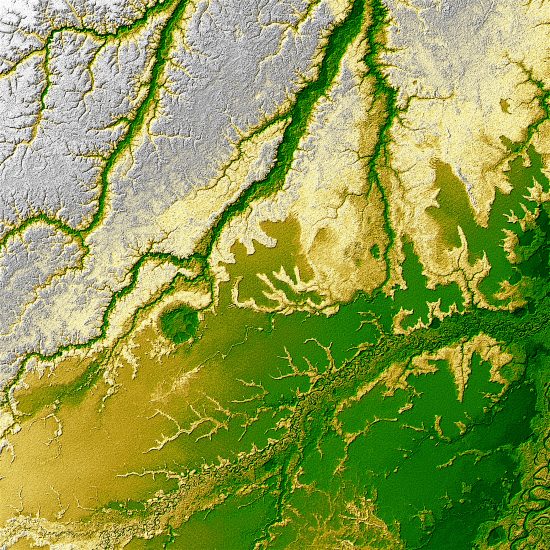
Topographic map of the Iturralde Structure in Bolivia. Credit: Shuttle Radar Topography Mission (SRTM) and NASA/JPL/NIMA. Click to enlarge.
Jan 4, 2017
Is this Bolivian crater an impact site?
It is the contention of Electric Universe proponents that many (if not all) large “impact” craters on Earth are actually the result of interplanetary electric discharges. Previous Picture of the Day articles describe some of those formations: Manicouagan, Popigai, Chicxulub, Sudbury and Vredefort Dome, among others.
South America is home to strange geological features that bear examination in light of an electrical origin, since they exhibit anomalous characteristics. Details about the Amazonian tepuis in Venezuela are not easy to explain with theories about gradual erosion over millions of years. Instead, it is suggested that they are the result of electricity carving the surface of the Earth at a time when human beings were alive to witness the events. This is a theory that is not easy to accept. For centuries, the microscopic actions of wind and rain gradually chipping away at gigantic stone monoliths has been the accepted theory. Hopefully, as more information comes to light, that viewpoint will expand to include fast-acting forces of change.
The Iturralde Structure (also known as Araona Crater) in northern Bolivia is a circular depression about 8 kilometers wide and 20 meters deep. It was found in Landsat satellite data, but because of rugged terrain and thick jungle it was not visited until 1998. It is thought that about 20,000 years ago a small comet struck the Earth. Since comets are believed to be loosely conglomerated the “pile of rubble” created a shallow depression. In 2002, a team of researchers entered the Bolivian rainforest in order to gather samples and to study the geography of the region.
Brecciated sediments were discovered in and around the crater environs. Magnetometer readings indicated that a heavy concentration of iron was located within the crater rim, but that the concentration could be from severe flooding in the past. No conclusive information about the crater’s origin was uncovered, but from a strictly visual perspective, it remains possible that it is electrical in nature.
In the image at the top of the page, it can be seen that the crater lies within a complex river system with hundreds of branches. It terminates one branch and is shot through with raised ridges. Around the crater are what is known as “inverted channels”. Instead of depressions, these formations are embossed into the terrain like a reverse river system. Fork-like bifurcations are all around. In an Electric Universe, such forking branches are known as Lichtenberg figures, named for Georg Christoph Lichtenberg.
In 1777, Lichtenberg described lightning-like figures in his “Super nova methodo motum ac naturam fluidi electrici investigandi” (“On a new method of movement and the nature of the electric fluid”). He used an electrostatic generator to discharge high voltages onto a dielectric insulator covered with dust. He recorded the figures by placing a piece of paper over the insulator, thereby attracting the dust images to it. Although his experiments created flat recordings, it is known today that the electrical branching effect takes place in three dimensions, as evidenced by other experiments in clear lucite blocks.
Also within the Iturralde Structure are elevated, radial forms indicative of diocotron instabilities. In laboratory experiments, charged particles attract, forming vortices of high charge density that rotate around the cylindrical axis of a plasma column. The clumps of particles generate vacuum gaps in the plasma, which are not replenished due to the low density. If the plasma column happens to be a gigantic lightning bolt striking the ground, the instability could leave areas of more-or-less density in the strata. This would create a central mound with radial ridges inside a circular depression. Such is the case with Iturralde.
Perhaps future discoveries will uncover other forensic details that will confirm or deny the electrical explanation, although no expeditions into the Bolivian wilderness are forthcoming.
Stephen Smith












